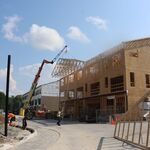k10ery
Senior Member
Oh, I followed your Osgoode comments. But I didn't want to rush you!
* Victoria College
William G. Storm, 1892.
Storm apprenticed under Thomas from 1845 to 1848, and formed a partnership with Cumberland that lasted until 1871. I've chosen Victoria College, rather than his St. Andrew's Church at King and Simcoe ( which owes something to Thomas's Cooke's Church of 1852 in design ) because, if I had to select one "hefty" Victorian building this is the one that's the most appealing to me. For one thing it's smaller than the more famous, rambling University College ( which he designed with Cumberland ) and more comprehensible, both at a glance and as one circumnavigates. Also, time has been kind to it in that it's now a hidden gem as a result of other university buildings going up around it - which enhances its surprise value when you see it for the first time. Built of Medina sandstone and polished granite, sporting pippypoos and doodads aplenty and as asymmetrical as one would expect for a Gormenghast-type college building of that date, it is nonetheless a finely balanced composition. Dweebs like Ruskin never missed a beat in dissing square-built Classically-inspired barns, and Pugin similarly opined that elements of a house should be expressed externally as, "distinctive and beautiful features" and Victoria College certainly looks from the outside that it does the right thing, but internally it is a simple three storey building with a large east/west central common on the main floor and centrally-located east/west corridors on the two upper floors with rooms opening off of them to the north and south. It thus avoids the wretched excesses of large, boorish asymmetrical British buildings of the time, where every broom closet and larder is given futile exterior expression.
As far as Richardsonian architecture goes not designed by Richardson himself I suppose this is inoffensive.
It seems overly fussy and pointy in comparison to, say, the Crane Library in Quincy, MA.
As to Vic, a good example of its type, though rather asymmetrical.
Once the language of Classically-inspired design hit the skids and the Mock Goths, and lovers of the Picturesque and miscellaneous Revivalist styles took over, it was all-asymmetry-all-the-time, though, with endless variations of turrets, pinnacles, crockets and busy skyline statements. Fortunately, being a colonial city of increasing but not overwhelming status, we were spared some of the worst examples. Hop the pond and see what the new class of wealthy British industrialists built as status homes, and what some of the nuttier aristocrats of the Victorian era had built, for instance.
But ... I really quite like British vernacular gothic in comparison to ours. They tend to be larger, more imposing, and taller than ours. So it's a bit more Addams family at times. But for a Canadian visitor to London or Birmingham etc. there's a neat presque vu quality when you go over there and see their Victorian neighbourhoods.




